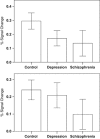Abnormal Frontostriatal Activity During Unexpected Reward Receipt in Depression and Schizophrenia: Relationship to Anhedonia
- PMID: 26708106
- PMCID: PMC4820052
- DOI: 10.1038/npp.2015.370
Abnormal Frontostriatal Activity During Unexpected Reward Receipt in Depression and Schizophrenia: Relationship to Anhedonia
Abstract
Alterations in reward processes may underlie motivational and anhedonic symptoms in depression and schizophrenia. However it remains unclear whether these alterations are disorder-specific or shared, and whether they clearly relate to symptom generation or not. We studied brain responses to unexpected rewards during a simulated slot-machine game in 24 patients with depression, 21 patients with schizophrenia, and 21 healthy controls using functional magnetic resonance imaging. We investigated relationships between brain activation, task-related motivation, and questionnaire rated anhedonia. There was reduced activation in the orbitofrontal cortex, ventral striatum, inferior temporal gyrus, and occipital cortex in both depression and schizophrenia in comparison with healthy participants during receipt of unexpected reward. In the medial prefrontal cortex both patient groups showed reduced activation, with activation significantly more abnormal in schizophrenia than depression. Anterior cingulate and medial frontal cortical activation predicted task-related motivation, which in turn predicted anhedonia severity in schizophrenia. Our findings provide evidence for overlapping hypofunction in ventral striatal and orbitofrontal regions in depression and schizophrenia during unexpected reward receipt, and for a relationship between unexpected reward processing in the medial prefrontal cortex and the generation of motivational states.
Figures




Similar articles
-
Pavlovian reward prediction and receipt in schizophrenia: relationship to anhedonia.PLoS One. 2012;7(5):e35622. doi: 10.1371/journal.pone.0035622. Epub 2012 May 4. PLoS One. 2012. PMID: 22574121 Free PMC article.
-
Blunted neural response to anticipation, effort and consummation of reward and aversion in adolescents with depression symptomatology.J Psychopharmacol. 2017 Mar;31(3):303-311. doi: 10.1177/0269881116681416. Epub 2017 Jan 16. J Psychopharmacol. 2017. PMID: 28093022
-
Fronto-striatal dysfunction during reward processing in unaffected siblings of schizophrenia patients.Schizophr Bull. 2015 Jan;41(1):94-103. doi: 10.1093/schbul/sbu153. Epub 2014 Nov 2. Schizophr Bull. 2015. PMID: 25368371 Free PMC article.
-
Revisiting reward impairments in schizophrenia spectrum disorders: a systematic review and meta-analysis for neuroimaging findings.Psychol Med. 2023 Nov;53(15):7189-7202. doi: 10.1017/S0033291723000703. Epub 2023 Mar 30. Psychol Med. 2023. PMID: 36994747
-
Neural Basis of Anhedonia and Amotivation in Patients with Schizophrenia: The Role of Reward System.Curr Neuropharmacol. 2015;13(6):750-9. doi: 10.2174/1570159x13666150612230333. Curr Neuropharmacol. 2015. PMID: 26630955 Free PMC article. Review.
Cited by
-
Humor in Psychiatry: Lessons From Neuroscience, Psychopathology, and Treatment Research.Front Psychiatry. 2021 May 28;12:681903. doi: 10.3389/fpsyt.2021.681903. eCollection 2021. Front Psychiatry. 2021. PMID: 34122193 Free PMC article.
-
Pleasant and unpleasant odor identification ability is associated with distinct dimensions of negative symptoms transdiagnostically in psychotic disorders.Schizophr Res. 2022 Oct;248:183-193. doi: 10.1016/j.schres.2022.08.011. Epub 2022 Sep 6. Schizophr Res. 2022. PMID: 36084492 Free PMC article.
-
A Possible Link between Anxiety and Schizophrenia and a Possible Role of Anhedonia.Schizophr Res Treatment. 2018 Jan 17;2018:5917475. doi: 10.1155/2018/5917475. eCollection 2018. Schizophr Res Treatment. 2018. PMID: 29593903 Free PMC article. Review.
-
Anhedonia in Depression and Schizophrenia: Brain Reward and Aversion Circuits.Neuropsychiatr Dis Treat. 2022 Jul 7;18:1385-1396. doi: 10.2147/NDT.S367839. eCollection 2022. Neuropsychiatr Dis Treat. 2022. PMID: 35836582 Free PMC article. Review.
-
Effects of gonadal steroids on reward circuitry function and anhedonia in women with a history of postpartum depression.J Affect Disord. 2022 Oct 1;314:176-184. doi: 10.1016/j.jad.2022.06.078. Epub 2022 Jun 28. J Affect Disord. 2022. PMID: 35777494 Free PMC article.
References
-
- Abler B, Erk S, Walter H (2007). Human reward system activation is modulated by a single dose of olanzapine in healthy subjects in an event-related, double-blind, placebo-controlled fMRI study. Psychopharmacology (Berl) 191: 823–833. - PubMed
-
- Argyropoulos SV, Nutt DJ (2013). Anhedonia revisited: is there a role for dopamine-targeting drugs for depression? J Psychopharmacol 27: 869–877. - PubMed
Publication types
MeSH terms
Grants and funding
LinkOut - more resources
Full Text Sources
Other Literature Sources
Medical

